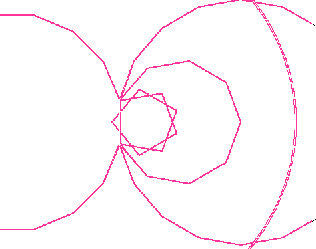Or search by topic
Number and algebra
Geometry and measure
Probability and statistics
Working mathematically
Advanced mathematics
For younger learners
First Forward Into Logo 6: Variables and Procedures



- Problem
First Forward Into Logo
Previous: FF5
In FF4 you investigated the instruction:
REPEAT 360 [FD 1 RT 1]
Hopefully you altered it as you saw fit and produced some exciting shapes. So it is timely to introduce you to the idea of a variable . As the word implies, a variable is something that varies, something that changes.
You may find the following a quicker way of drawing circles and circular patterns. It is called a procedure and has to be written in a particular way.
TO CIRCLE :CH
REPEAT 360 [ FD :CH RT 1]
END
Notice how the procedure is set out:
First a title / a command TO CIRCLE
then the variable :CH
followed by the instructions REPEAT 360 [ FD :CH RT 1]
then a formal closing of the procedure END
N.B. the variable, :CH could have been any letter or letters that you wish!
|
Now experiment with the procedure:
CIRCLE 3
CIRCLE 6
CIRCLE -3
CIRCLE 9
|
 |
Building on this idea of a procedure we could have written:
TO CIRC :CH :ANG
REPEAT 360 [ FD :CH RT :ANG]
END
This is a procedure with two variables!
Can you anticipate what will change and what will happen now?
Can you see what is now possible?
Go on experiment! Try:
CIRC 3 3
CIRC 3 6
CIRC 3 30
What is happening?
|
Why not be bolder and try say:
CIRC 30 90
CIRC 30 45
CIRC 30 18 etc., etc.,
|
 |
What do you notice?
What conclusions can you come to?
Next: FF7
Related Collections
You may also like
First Forward Into Logo 1: Square Five
A Short introduction to using Logo. This is the first in a twelve part series.
LOGO Challenge 1 - Star Square
Can you use LOGO to create this star pattern made from squares. Only basic LOGO knowledge needed.
LOGO Challenge 5 - Patch
Using LOGO, can you construct elegant procedures that will draw this family of 'floor coverings'?

